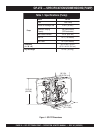
PAGE 12 — QP- 2TZ TRASH PUMP — OPERATION & PARTS MANUAL — REV. #0 (03/25/05)
QP-2TZ — GENERAL INFORMATION
APPLICATION
The
QP-2TZ Trash Pump
is designed to be used for dewatering
applications. Both the suction and discharge ports on the
QP-2TZ trash pump use a 2-inch diameter opening, which
allows the pump to pump at a rate of approximately 211 gallons/
minute (gpm) or 800 liters/minute (lpm).
Trash or self-priming pumps are designed to purge air from the
suction line and create a partial vacuum in the pump body. The
reduced atmospheric pressure inside the pump allows water to
flow through the suction line and into the pump body. The
centrifugal force created by the rotating impeller pressurizes the
water and expels it from the pump.
Engine
This trash pump is powered by a 4.6 horsepower, air-cooled,
HATZ 1B20
diesel engine.
Trash Pump
Trash pumps derive their name from their ability to handle a
greater amount of debris and solids than standard centrifugal
pumps. This pump generally handle solids up to 1/2 the size of
the discharge opening making them less likely to clog. Also trash
pumps are capable of handling water with 25% solids by weight.
The advantage of using a trash pump is that it can be quickly and
easily disassembled in the field "
without tools
" and easily
cleaned when clogged.
Suction Lift
This pump is intended to be used for dewatering applications
and is capable of suction lifts up to 25 feet at sea level. For
optimal suction lift performance, keep the suction hose or line as
short as possible. In general, always place the pump as close to
the water as possible.
Pump Support
The pump should always be placed on
solid stationary ground
in a level position.
NEVER place the pump on
soft soil
. The suction hose or pipe
connection should always be checked for tightness and leaks. A
small suction leak in the hose or fittings could prevent the pump
from priming.
Elevation
Higher elevations will effect the performance of the pump. Due to
less atmospheric pressure at higher altitudes, pumps DO NOT
have the priming ability that they have at sea level. This is due to
the “thinner air” or lack of oxygen at higher altitudes.
A general rule of thumb is that for every 1,000 feet of elevation
above sea level a pump will lose one foot of priming ability.
For example, in Flagstaff, Arizona where the elevation is
approximately 7,000 feet, the pump would have a suction lift of
25 feet rather than the 18 feet at sea level. Table 3 shows suction
lift at various elevations.
Table 4 shows percentage drops in performance as elevation
increases.
snoitavelEsuoiraVtatfiLnoitcuS.3elbaT
edutitlA
)sreteM(teeF
)sreteM(teeFnitfiLnoitcuS
leveLaeS)840.3(0.01)275.4(0.51)690.6(0.02)026.7(0.52
)016(000
,2)086.2(08.8)320.4(2.31)463.5(6.71)507.6(0.22
)912,1(000,4)773.2(08.7)665.3(7.11)457.4(6.51)349.5(5.91
)928,1(
000,6)301.2(09.6)961.3(4.01)602.4(8.31)372.5(3.71
)834,2(000,8)988.1(02.6)438.2(03.9)977.3(4.21)427.4(5.51
)840
,3(000,01)737.1(07.5)126.2(06.8)474.3(4.11)853.4(3.41
suoiraVtassoLecnamrofreP.4elbaT
snoitavelE
edutitlA
sreteM(teeF
wolFegrahcsiDdaeHegrahcsiD
leveLaeS%001%001
)016(000,2%79%59
)912,1(000,4%59%19
)928,1(000,6%3
9%78
)834,2(000,8%19%38
)840,3(000,01%88%87


















